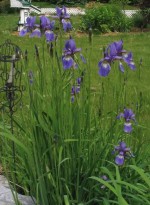
Type: Herbaceous perennial.
Bloom: Blue, purple, white. pink, wine, yellow; late spring, some may rebloom in fall.
Size: 1’-3’ H x 1’+ clumps.
Light: Full sun but tolerates some shade.
Soil: Very moist, well drained; pH 6.1-7.8 (neutral to slightly acid).
Fertilizer: Add organic mulch in spring.
Hardiness: Zones 4-10 but do not do well in hot- humid conditions.
Care: Cut back foliage in winter or early spring and weed frequently as grasses may become a terrible pest.
Pests and Diseases: No significant pests; not susceptible to iris borer or fungal leaf diseases.
Propagation: Division of clumps in spring; these iris do not like being disturbed and may take a couple of years to recover.
Companion plants: Lamb’s ear (Stachys byzantina), ‘Johnson’s cranesbill (Geranium x ‘Johnson’s blue), peony (Paeonia hybrids), catmint (Nepeta x faassenii).
Outstanding Selections: ‘Butter and Sugar’ has bright yellow falls and wide, creamy white standards, ‘Flight of Butterflies’ has graceful small blue flowers on 2½ foot tall plants, Caesar’s Brother’ has dark purple flowers on 36 inch tall plants. ‘Eric the Red’ has dark wine-red flowers and grows 36 inches tall.
Comments: Siberian iris are lovely in a vase but do not last long.
